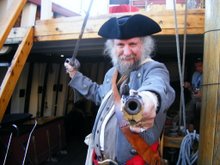I just finished reading Captain Blood by Rafael Sabatini for the third time. I have been a fan of Sabatini since several of his novels were reprinted in the 1970s but this is one of his best. It has several of Sabatini's recurring themes - a noble and witty hero who is forced by circumstances to become an adventurer and a romance foiled until the last moment by bad luck and misunderstanding.
In this book, Peter Blood is a former soldier who has taken up the more peaceful practice of medicine. He refuses to participate in the Monmouth Rebellion against James II but is arrested and convicted anyway for treating a wounded rebel. Rather than being executed, he is sent to the Caribbean to be sold as a slave. Eventually he and some of his fellow slaves escape and steal a ship. Even then, Blood's first goal was to simply resume his career as a doctor. Circumstances make piracy his main choice and he proves a natural at it.
Sabatini's hero is not a typical pirate. Instead he is honorable, rescuing women and only raiding Spain.
One section of the book was lifted from Captain Morgan's real exploits. Sabatini explains this away by saying that they were really Blood's exploits and that Morgan later claimed credit for them.
Fortunately for Blood, he is opposed at every turn by opponents whose self-importance exceeds their competence. This makes the villains of the book easy to hate.
This is one of the best pirate novels ever written. Blood is believable as a pirate with principles and, unlike Treasure Island, the book has several sea battles. If it has any faults it is that it makes these battles seem too easy. A broadside or two and the battle is decided and any blood spilled is spilt out of sight.
It should be no surprise that the book is longer and more complex than the movie which, in itself, is one of the better pirate movies.
Wednesday, March 9, 2011
Monday, March 7, 2011
Searle's Raid
As Spain's northern-most colony, St. Augustine was a natural target for pirates from Francis Drake (in 1585) to Robert Searle (in 1668). Drakes's and Searle's raids are reenacted annually. This year Searle's Raid was held on March 4th and 5th.
There are actually two separate events. A military camp was set up at the Fountain of Youth park on Friday and Saturday with cannon demonstrations and other military drills. At 4:00 trolleys carried the participants to the site of the battle in the oldest part of St. Augustine. The forces were split into English attackers and Spanish defenders with the attackers having slightly higher numbers. Searle's actual force was only around 40 men against a garrison of 35 Spaniards.
The battle itself was a fairly long one for reenactors. It began at five o'clock when the English fired from a couple of locations near the Plaza. The forces met at the Plaza and the Spanish were eventually forced to retreat through the streets of the town. There was more firing at designated locations before the battle was rejoined at a redoubt near the Huguenot Cemetery. Eventually the Spanish were forced to surrender. The battle finally ended around six fifteen.
The combatants included musketeers, pikemen, small cannon, and swordsmen engaging in choreographed duels. Along the way a tavery was looted and three women taken prisoner for ransom.
This is an unusual event, straddling both pirate and 17th century military. On one hand, Searle was a pirate nominally he was a privateer but his commission had been withdrawn) and many of the participants are pirate reenactors. On the other hand, the historic event took place before the Golden Age of Piracy and the differences in the clothing are obvious. It was the only pirate event I have been at that included marching and pikes. Matchlock muskets were common. Pistols and blunderbusses were rare. During the fight, the English were cheering for King Charles.
Either way, I felt right at home.
Historic note - Robert Searles was a privateer and pirate during the time of Henry Morgan. He was arrested but released without punishment for the raid on St. Augustine. Later he was a sub-commander during Morgan's raid on Panama. His raid on St. Augustine was moderately successful. The Spanish silver he had hoped to steal had already been shipped to Spain but the Spanish paid him heads of cattle to leave. In addition, his men sacked the city and took hostages to ransom. This raid finally convinced Spain that the city needed better fortifications than a wooden fort and four years later construction began on the existing stone fort.
There are actually two separate events. A military camp was set up at the Fountain of Youth park on Friday and Saturday with cannon demonstrations and other military drills. At 4:00 trolleys carried the participants to the site of the battle in the oldest part of St. Augustine. The forces were split into English attackers and Spanish defenders with the attackers having slightly higher numbers. Searle's actual force was only around 40 men against a garrison of 35 Spaniards.
The battle itself was a fairly long one for reenactors. It began at five o'clock when the English fired from a couple of locations near the Plaza. The forces met at the Plaza and the Spanish were eventually forced to retreat through the streets of the town. There was more firing at designated locations before the battle was rejoined at a redoubt near the Huguenot Cemetery. Eventually the Spanish were forced to surrender. The battle finally ended around six fifteen.
The combatants included musketeers, pikemen, small cannon, and swordsmen engaging in choreographed duels. Along the way a tavery was looted and three women taken prisoner for ransom.
This is an unusual event, straddling both pirate and 17th century military. On one hand, Searle was a pirate nominally he was a privateer but his commission had been withdrawn) and many of the participants are pirate reenactors. On the other hand, the historic event took place before the Golden Age of Piracy and the differences in the clothing are obvious. It was the only pirate event I have been at that included marching and pikes. Matchlock muskets were common. Pistols and blunderbusses were rare. During the fight, the English were cheering for King Charles.
Either way, I felt right at home.
Historic note - Robert Searles was a privateer and pirate during the time of Henry Morgan. He was arrested but released without punishment for the raid on St. Augustine. Later he was a sub-commander during Morgan's raid on Panama. His raid on St. Augustine was moderately successful. The Spanish silver he had hoped to steal had already been shipped to Spain but the Spanish paid him heads of cattle to leave. In addition, his men sacked the city and took hostages to ransom. This raid finally convinced Spain that the city needed better fortifications than a wooden fort and four years later construction began on the existing stone fort.
Subscribe to:
Posts (Atom)

